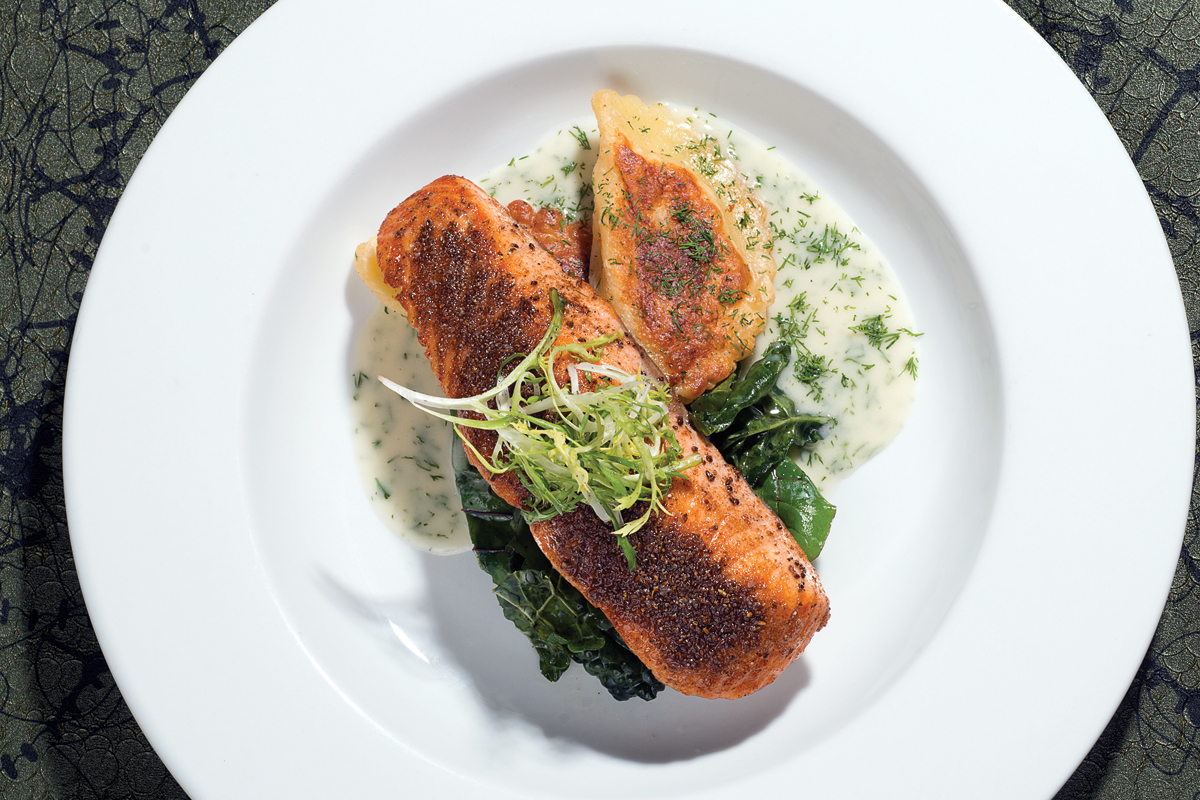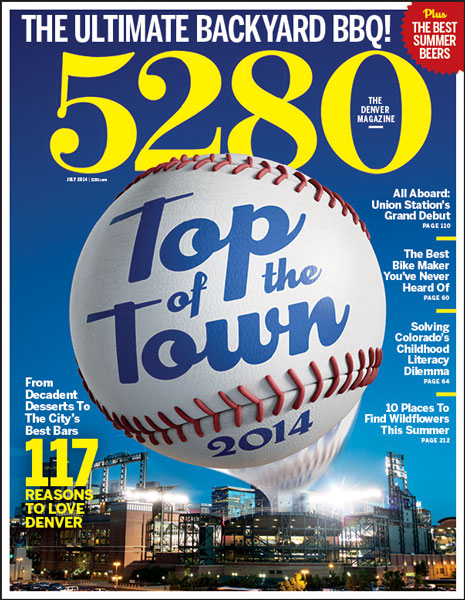The Local newsletter is your free, daily guide to life in Colorado. For locals, by locals.
For more information about how 5280‘s rating system works, read this post from critic Stacey Brugeman.
Late into my first visit to the Plimoth—long after Peter Ryan had finished firing umpteen orders of his cult-inspiring cauliflower gratinée for a characteristically packed house—the chef-owner walked into the dining room. As my companion and I savored an eggy apple-and-cherry clafoutis, the 43-year-old, bedecked in his chef’s whites and a camouflage baseball cap, pulled a chair from the centermost table and sat down. Was he that beat? I wondered. After months of gutting and rebuilding a long-since-deteriorated soda fountain in a raw neighborhood north of City Park, such exhaustion would have been justified. And perhaps he was tired. But in that moment, Ryan sat down not because he was tired but to check the dining room’s acoustics.
On another night, as I studied the kale green Italian wallpaper Ryan hunted down from a warehouse in Belgium, our server returned to the table to ask if I wanted the beer pairing I’d ordered immediately or with my entrée. When delivering my date’s dish of crispy, skillet-flattened chicken breast and confit thigh with spicy shrimp étouffée, she walked across the 95-year-old tiles to the far end of our table to ensure he wasn’t served from the wrong side. That same night, change for our bill came with an overabundance of singles so we weren’t bullied into any tip other than the one we thought was fair.
A visit to the Plimoth’s bar—made with reclaimed pipe and joists discovered when Ryan installed the kitchen’s hood system—was equally revealing. “I’ll take a Templeton Rye on the rocks,” an industry insider ordered. “Would you like a bunch of little rocks or one big cube?” the bartender asked. “One big cube,” the customer clarified.
Instead of turning to a $5,000 ice machine or a hotel pan of hand-chipped globes, however, that barman grabbed a plastic-wrapped silicone tray from a freezer the size of a dorm fridge. You see, the Plimoth isn’t a place where resurrected ’90s hip-hop blares from Spotify or an iPod playlist; instead, John Coltrane’s saxophone wails from a six-disc changer sitting at the end of the bar. Chef Ryan didn’t walk into his 45-seat dining room that night from a high-tech kitchen outfitted with a Combi oven, a Cryovac machine, and a Pacojet. Instead, he came from an 11-by-11-foot kitchen with a six-burner range, cast-iron cookware, and a magnetic strip of mismatched vegetable peelers above the sink. The Plimoth is not the pet project of deep, corporate pockets, nor the latest outpost of a chef who’s a household name. It’s an inviting, affordable neighborhood restaurant—one that’s named for the historical spelling of Ryan’s hometown of Plymouth, Massachusetts. Funded by Ryan’s friends and family, it’s the first independent project from a 10-year culinary school instructor who fully understands (and can’t help but teach his staff) that even the tiniest details—from acoustics to correct change to ice cubes—matter.
“Is the music right, is the temperature right, is your stemware right?” Ryan—who sweeps cigarette butts and empty airline bottles of vodka off his sidewalks every day before service—asks during our phone interview. “People don’t go out just for the food anymore,” he says. Indeed, his keen attention to detail is felt throughout the experience, especially in the Plimoth’s food.
Crafted with Charles MacDonald and Javier Cruz, two fellow Z Cuisine and Cook Street School of Culinary Arts alums, Ryan’s menu is not one of trendy bites nor sharable carving boards that attempt to dictate the way we eat. Instead, the Old World–inspired collection of appetizers, entrées, and desserts—each listed with a suggested wine or beer pairing—fits on one page. “I would rather do fewer things great than more things good,” Ryan says.
Over the course of enough visits to taste every single menu offering, I snatched our table’s last gob of a creamy, house-smoked steelhead trout mousse, served with a clever and bright caper, almond, and kale pesto. A roasted beet salad—an old favorite that’s hard to make new again—came with tender confit duck gizzards that had been cured overnight. A server delivered a starter of charred broccoli rabe Ryan had plated over a generous swath of Sicilian mayonnaise made with red pepper–infused oil. A bowl of Prince Edward Island mussels came with succulent pieces of house-made fennel sausage and long strands of hollow bucatini laced with translucent shavings of lardo. The kitchen turned out a beef shank (braised for six hours) with a pleasantly acidic “matignon” of bacon, mirepoix, tomato paste, red wine, and braising juices. A Scottish salmon entrée landed on our table as a simple, perfectly seasoned, skillet-kissed piece of fish alongside a generous heap of Madeira-glazed shiitake mushrooms; sweet, caramelized leeks; and a comforting bed of course-ground
Parmesan polenta.
Adam Knickerbocker—who hails from Denver Country Club and European dining rooms that feature maître d’s, synchronized service, and silver domes—oversees the Plimoth’s service. At its best, you can sense that his philosophy is rooted in these formal traditions but has the more approachable ease of a neighborhood eatery. The bartender greets you like an old friend. Servers enthusiastically talk about cooking techniques, pasta shapes, ingredient sourcing, and a recent tour of the aquaponic growing practices at Flourish Farms. A waitress asks the kitchen to split a shared entrée. Just seconds after clearing plates, she wipes up drops of kale pesto that landed on the table instead of your crostini. More often than not, someone folds your napkin while you are studying the cookbooks on display in the bathroom. The staff asks whether you’d like sugar or a twist with your espresso.
While our server’s wine knowledge was somewhat disappointing on my first visit—she used the word “sweet” to describe an Italian bubbly labeled “secco” (by definition, secco means dry)—it was obvious during later experiences with the same staffer that Knickerbocker’s daily tastings, repeated pours, and staff tours were starting to pay off. The manager could also work with his team on dish presentation. While he himself brought items to our table with explanations about the components of a dish or, say, hints about using a mustard sauce sparingly, his staff set plates down with a smile but little detail.
Ryan’s kitchen isn’t without fault, either. Waffle-cut potato chips meant to be the gratis opener arrived during only one visit—on all other occasions, the kitchen had run out. A menu of just 10 savory dishes relies a bit too much on crostini: A mousse, rillette, and gratinée all demand bread rounds, and three additional items arrived with them. More important, while dishes were compelling, flavorful, and well seasoned, sourced, and plated, the kitchen would do well to think a bit more about texture. Crostini were, at times, dry and over-toasted. I wanted more snap from the casing of a house-made brat served with an otherwise recommendable choucroute garnie. Our bucatini was ever-so-slightly overcooked. The potatoes accompanying that braised beef shank were starchy. The pears Ryan’s team put into one of the most flaky, buttery tart crusts in recent memory were a day too mushy.
In light of everything Ryan and his team at the Plimoth are getting right, it seems the chef-owner is his own worst critic. When I mentioned how hard it was to hear during my visits, for example, Ryan explained that was the reason I spotted him in the dining room that first night. Shortly thereafter, the chef decided to turn down the hood system during service and install acoustic panels on the ceiling. He gives MacDonald, Cruz, and others credit long before he gives it to himself, making it sound as if he’s the one who’s inspired by them.
Between stints at Z Cuisine and restaurants on the East Coast, Ryan spent more than a decade as an instructor at his own alma mater, Cook Street School of Culinary Arts. While the plan has long been to get back in the kitchen and open this place he’s been dreaming about since 2004, it seems Ryan can’t really get away from teaching. His work at the Plimoth offers all of Denver important lessons: Details really do matter, and getting a small number of things right is more important than tackling too much. This talented leader proves that we should expect such excellence from all Denver restaurants—even “just” a neighborhood spot.
The Plimoth: 2335 8th Ave; 303-297-1215; theplimoth.com
3.5/5 Stars
The Draw: This cozy, Old World-inspired restaurant is a quintessential neighborhood spot, but it’s performing as well as many destination eateries.
The Drawback: The transitioning neighborhood is not ideal for showcasing Denver to out-of-towners.
Don’t Miss: Cauliflower-turnip gratinèe, smoked trout mousse, mussels with spicy fennel sausage and bucatini, cast-iron salmon, choucroute garnie, and Denver-brewed beers
Details: Entrees at dinner, $17 to $19, Street parking. Open 4 p.m. to 9 p.m. Tuesday through Thursday and 4 p.m. to 10 p.m. Friday and Saturday. Reservations encouraged.









